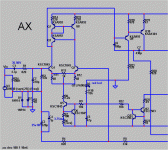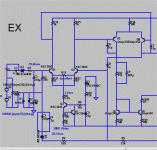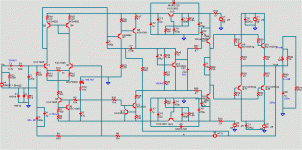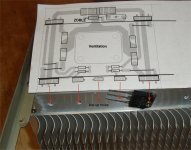So OS
The circuit in 1481 is the BEST you know and LIKE the most...
Please indicate if any of the devices have to be thermal coupled to ??? and maybe if I have a break from all the soldering and testing I am currently up to, a S-Layout might fall out of the sky. With a separate front-end power supply like I am doing now.
With a separate front-end power supply like I am doing now.
How many Lateral outputs will those ON-Semi's 32's and 33's drive?
The circuit in 1481 is the BEST you know and LIKE the most...
Please indicate if any of the devices have to be thermal coupled to ??? and maybe if I have a break from all the soldering and testing I am currently up to, a S-Layout might fall out of the sky.
How many Lateral outputs will those ON-Semi's 32's and 33's drive?
So OS
The circuit in 1481 is the BEST you know and LIKE the most...
Please indicate if any of the devices have to be thermal coupled to ??? and maybe if I have a break from all the soldering and testing I am currently up to, a S-Layout might fall out of the sky.With a separate front-end power supply like I am doing now.
How many Lateral outputs will those ON-Semi's 32's and 33's drive?
(Below 1/2) are the 2 best , durable and best sounding results of my "fiddling".
Both have been running for months and I am satisfied with the sound. The TO-126 devices (ksc3503,ksa1381 / mje340-350) are thermally coupled to a small piece of aluminum. Any 2Q's (IPS CCS , LTP,CM) are "face to face" coupled. Next I will pick 2 OPS's to go with these rock solid voltage stages. 1 will be BJT , 1 will be Lfet ... 4 or 6 devices.
Instead of the 200W/8R amps I have been doing , a good 120-150 watter with 4R capability is more of a diyer's "sweet spot". I have looked around Ebay , this forum , everywhere else and the "mid" sized amp is the most popular.
PS. the 15032/33's will drive nearly an unlimited # of Lfets. 6-8 pairs or many more with 80V rails (monster amp). 4 pair BJT is the limit without a triple... but in the case of a triple I would just use another njw0302/0281 pair as the driver with the 6+ pair - monster OP stage
OS
Attachments
Last edited:
the mirror accuracy is affected by the base currents that are abstracted from the side that they are connected to.
the 2Q version takes all it's base current from one side only. That leaves the "error" to be equaled by some compensation system/method.
Adopt your compensation method.
Now change the mirror devices. If they are not matched then the compensation can no longer match the error.
Similarly with the 4Q version.
Matching of the devices allows the compensation to be set up to remove mirror "error".
replace either of the pairs with mismatched devices and the compensation no longer matches the error.
If the mirror is not accurately set up then the LTP cannot be balanced. It is this balance that OST's range of module has shown is critical to getting the best results from the input stage.
I have been preaching this for years. Few if any wanted to believe.
I was a bit like John the Baptist, I believed but I did not have the evidence. OST is a bit like Christ who came along a bit later with the real message and the proof that it works and how to do it.
Andrew, nothing I say contradicts with this. However in my experience base current is the least of our troubles. The devices should be matched. However 2 things will affect this matching - temperature and Early effect. Both of these vary Vbe, and throw off matching. Early affect distorts the natural Vbe transfer curve, so matching is thrown off any time the Vce of the output transistor changes. Temperature decreases Vbe, so the higher dissipation side will have more current.
In practice Early effect has little effect on the LTP because the Vce of the output transistor is very constant. In the VAS it matters more. Temperature depends on whether the Vce is equal for both transistors. This may not be true if you use a Darlington VAS. I think it is better to match temperature by matching dissipation in the design, than to expect thermal coupling to take care of it, although I haven't actually calculated the difference.
- keantoken
I still may include the 1K trimmer between Q1-2 ... for the newbiees.
R18 becomes a 220R + a 500R trimmer. That's all , folks (besides a 4-device L-FET OPS)
PS - here's a thought ... if you tweak a circuit and you can measure an improvement electrically (offset /balance/current) but hear little or no sonic improvement, have you really improved it ??? Another example - the last change with the CCS's eliminated the "thump/click" , but did not change the sonics.
OS
If you improved it electrically, and hear no sonic degradation or improvement, then you probably removed a limiting factor.
The sonic improvement could then be expected available at a different location. Well, that's my guess.
As your amplifier is already very clear sounding, a possible sonic improvement remains, and I'll try to describe it--pardon my writing. . .
When you make a minor change, listen to music and see if you can detect more or less "slight pressure" feeling in or around the ears, and aim for "less" pressure. So, that's a pretty good deciding factor when you've got two otherwise very similar options.
Maybe it's time to improve ears as any amplifier improvement can't be measured using ears....here's a thought ... if you tweak a circuit and you can measure an improvement electrically (offset /balance/current) but hear little or no sonic improvement, have you really improved it ??? Another example - the last change with the CCS's eliminated the "thump/click" , but did not change the sonics...
If instruments can measure the improvment, we can conclude they are more sensible.
BTW, I think I would stop earing improvement far before 0.0001%..!
That clean AX design (proportional harmonics) is particularly intriguing.
I'd love to see the AX go in to production, in several different power output levels.
There's no need to ear tune that AX, except for possibly adding preamplifier(s) to address the needs of various different sources.
I'd love to see the AX go in to production, in several different power output levels.
There's no need to ear tune that AX, except for possibly adding preamplifier(s) to address the needs of various different sources.
Finally got my mongrel up and running after my mistake in putting the BX board in upside down in the PB120N. Brain fade!!! I had redone the output board from SNG001's PB120-45 to Os's PB120N as I increased the voltage to 60v and wanted to use the cap multiplier. I didn't realise that the vb's now mount vertically on Os's board so pretty much fried every transistor on both boards.
Anyway all is sweet now and am happy with the results. The sound compares well to my SKA GB150 amp.
Now I just need to tidy it all up and put the lid on, then move onto the next project, speakers.
I'm thinking about building the Scan-Speak Rediscovery Loudspeaker Kit, any thoughts?
Pete
Anyway all is sweet now and am happy with the results. The sound compares well to my SKA GB150 amp.
Now I just need to tidy it all up and put the lid on, then move onto the next project, speakers.
I'm thinking about building the Scan-Speak Rediscovery Loudspeaker Kit, any thoughts?
Pete
. . .Now I just need to tidy it all up and put the lid on, then move onto the next project, speakers.
I'm thinking about building the Scan-Speak Rediscovery Loudspeaker Kit, any thoughts?
Pete
This thread contains high power amplifiers.
Ask any professional singer how much they hate the gross distortion of 2-way speakers at high power.
That speaker and the little Oriole speaker are both capable of about 30 watts (LM1875) before distorting.
Oriole <<Link
I'd alter the zobel a bit, but otherwise its a good speaker with a better tweeter. Both the Scan Speak kit and its much cheaper competition have an additional flaw in common. That's a rock hard dust cap that acts as a buzzer and its muffled via zobel, with the consequence that mismatched dispersion patterns send tweeter output and woofer output with disproportionate harmonics at off angle and from room reflections.
This sort of thing isn't seemly with high power amplifiers.
Instead. . .
Now, the following are two speakers of 3-way design so that voices aren't shaken up by a moving woofer, and the smaller (Statement) has no dust caps, while the larger (Magna) has a fabric that breathes for dust cap on the voice band speaker driver. Both technically feature a full range driver (wideband driver) that doesn't jiggle when the woofer makes bass:
Statement:
Statement <<Link
A high class sort of thing. This makes good use of OStripper's parallel output devices. The woofer isn't electrically muffled, and therefore the bass is very clean. RS180-8 handles 80 to 100 watts, but you can use it with the 120 watt per channel amplifier.
*Statement also has some smaller sisters (Mini Statement, Statement Monitor) if you want something in the common 60 watt per channel range, in the range of the TDA7294 and "MyRef" amplifiers. Since the price is similar to the full size speaker, I'm not recommending the downgrade. . . unless size is the main concern.
Magna:
Magna <<Link
This features a similar design to the "Statement" plus much additional power handling. I think that the cabinet needs to be about an inch wider. Dayton model SD315A-88 in series handle up to 240 watts (4 ohm woofers in series) and there are other DVC and 4 ohm models available with similar efficiency and even higher power handling.
Many woofer selections are possible.
Mechanical baffle step compensation is in use so that the woofer+cabinet+crossover needs to be at 94db efficiency or higher for all pitches below the baffle step frequency. You can adjust the cabinet width and port tuning to match that up.
Its also possible to adapt this design to use 8 ohm woofers in parallel (makes 4 ohm and +3db); however, in that case, power handling is the same as a single woofer.
P.S.
The amplifiers on this thread are designed to play cleanly at high power. Even if the power is mainly used for dynamics reserve, you still need 3-way design so that your favorite vocalist doesn't sound as if they're standing behind a fan when the woofer is moving to make bass.
Last edited:
Finally got my mongrel up and running after my mistake in putting the BX board in upside down in the PB120N. Brain fade!!! I had redone the output board from SNG001's PB120-45 to Os's PB120N as I increased the voltage to 60v and wanted to use the cap multiplier. I didn't realise that the vb's now mount vertically on Os's board so pretty much fried every transistor on both boards.
Anyway all is sweet now and am happy with the results. The sound compares well to my SKA GB150 amp.
Now I just need to tidy it all up and put the lid on, then move onto the next project, speakers.
I'm thinking about building the Scan-Speak Rediscovery Loudspeaker Kit, any thoughts?
Pete
Glad to hear that ,Repeet. I have had some malware issues and have had to deal with those. Crazy thing is ... there was no virus or malware !!
My next project is to retrofit a Nikko Alpha 230 with the AX and a 6 device BJT OPS. This will be the direct prototype of my proposed commercial AX "kit".
I chose 3 pair as this one will run from nominal +/-60Vdc , be conservatively rated at 120/240 watts (8/4R) , and have a MTBF of decades (tight package).
The Nikko's trafo is 600VA (46-43-0-43-46Vac) dual secondaries with a common CT giving (63-58-0-58-63Vdc). This will allow for the separate voltage stage/ power stage setup. My existing PB250/ax will be for sale as will be a set of perfect PB250/ax blank boards. The big heavy Genesis will be sold as well (Very nice case) ... too freakin' big...
OS
I've decided on the Mini Statements. Now to start ordering everything and learning some new things.
Pete
The Mini Statement has a lot to offer and the high current capacity of the BX and AX is a good match. Considering the 4 ohm speakers, you won't need as much transformer voltage, but it will need to be a sturdy transformer (higher VA figure).
It seems that Mini Statement is a pro style speaker at a convenient size, also featuring cohesive full range sound that reaches a long distance, including other rooms in the home, clearly, as if a live band. Such are the features of most wideband style speakers--clear cohesive vocals, along with a plentiful helping of everything else.
RS180 scales 60w, no matter if in parallel or single. Solid state 60w means 150w amplifier, if one allows a "maximally" generous 60% margin for headroom. This will help you determine transformer voltage. Paralleled RS180's will use 120 watts at 4 ohms (same transformer voltage as 60 watts at 8 ohms).
With 4 ohm speakers, triplicate (and greater) paralleled output devices can help prevent excess heat, especially if that's what you aim for.
Mini Statement, like Magna, increases load at frequencies below baffle step boost. Magna goes from 12 ohms down to 8 ohms; however, Mini Statement goes down to 4 ohms. Crossover on baffle step is a sort of pro style speaker that doesn't rely on signal loss to accomplish baffle step compensation.
More to the point, its a high quality 3 way speaker so you can use OStripper's high power amplifier without flapping the same speaker driver used for vocals.
P.S.
WAF factor could be speaker stands with "skinny" woofers inside: Tang Band W69-1042J 6"x9" Subwoofer See? The *minimum* woofer for these amplifiers isn't necessarily rowdy 10" woofers in big boxes. 100 watts at 8 ohms handling plus a generous 60% margin for headroom is approximately a 250 watt amplifier. The baffle step boost goes to 450hz = 10" wide cabinet, and that's just for example.
This can make skinny "bass cabinet speaker stands" suited for any mini monitor, like Oriole and also certainly including the midrange and treble drivers of Mini Statement (changes would be lighter 8 ohm load and a much smaller cabinet, but not necessarily any difference in maximum output).
Well, a pair of 8 ohm 6x9 subwoofer drivers is my own plan to get OStripper's high power, high fidelity, amplifier output into tiny speakers.
Finally, I have the $20 Nikko .
I took longer that I would have expected , but I am not disappointed. The unit was in excellent shape externally (pictures 1-4). Very heavy construction , a 600VA (48-43-0-43-48 / 8 and 16v - 3 secondaries) toriod trafo -tested perfectly .. perfect for a Mongrel PB120+ with dual supplies. The original amp was quite fried , the 15kuF supply caps leaked and burned .. destroying the main PS board and bridge (pix 5-7). The caps were huge, rated at 71WV/5 pin snap-ins ... they failed allowing full unrectified AC to go right to the amp , blowing the VAS,drivers ... everything. All the main amps caps had the tops blow off them (firecrackers ) ,the Bridge had the leads fall right out.
) ,the Bridge had the leads fall right out.
I'm past the "dirty work" already , case -heatsinks -trafo ... all cleaned in alcohol , boards stripped out , trafo and front power meter tested AOK .
.
To "implant" a mongrel will be quite easy , might not even have to drill any holes (pix8/9). Unlike the other Nikko alpha thread , I WILL !!! complete this soon .. I have plenty of parts (enough for dozens of amps) and the necessary motivation.
This will be the final prototype for the "KIT" , I will perfect and audition before I pass it on for DIY . With the pretty meters , better parts , and my nice PCB work ... this should work out VERY good.
. With the pretty meters , better parts , and my nice PCB work ... this should work out VERY good.
OS
I took longer that I would have expected , but I am not disappointed. The unit was in excellent shape externally (pictures 1-4). Very heavy construction , a 600VA (48-43-0-43-48 / 8 and 16v - 3 secondaries) toriod trafo -tested perfectly .. perfect for a Mongrel PB120+ with dual supplies. The original amp was quite fried , the 15kuF supply caps leaked and burned .. destroying the main PS board and bridge (pix 5-7). The caps were huge, rated at 71WV/5 pin snap-ins ... they failed allowing full unrectified AC to go right to the amp , blowing the VAS,drivers ... everything. All the main amps caps had the tops blow off them (firecrackers
I'm past the "dirty work" already , case -heatsinks -trafo ... all cleaned in alcohol , boards stripped out , trafo and front power meter tested AOK
To "implant" a mongrel will be quite easy , might not even have to drill any holes (pix8/9). Unlike the other Nikko alpha thread , I WILL !!! complete this soon .. I have plenty of parts (enough for dozens of amps) and the necessary motivation.
This will be the final prototype for the "KIT" , I will perfect and audition before I pass it on for DIY
OS
Attachments
-
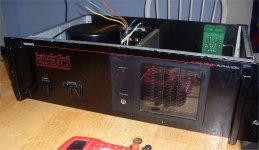 nikko230front.jpg317.6 KB · Views: 556
nikko230front.jpg317.6 KB · Views: 556 -
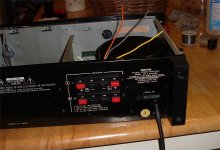 nikko230rear.jpg731.3 KB · Views: 509
nikko230rear.jpg731.3 KB · Views: 509 -
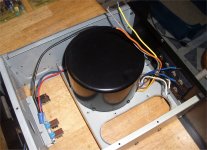 nikko230trafo.jpg366.3 KB · Views: 469
nikko230trafo.jpg366.3 KB · Views: 469 -
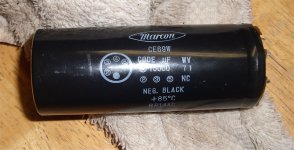 caponfire2.jpg154.4 KB · Views: 168
caponfire2.jpg154.4 KB · Views: 168 -
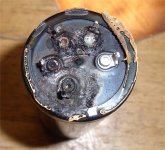 caponfire.jpg142.5 KB · Views: 415
caponfire.jpg142.5 KB · Views: 415 -
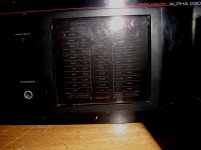 nikkometers.jpg275.4 KB · Views: 425
nikkometers.jpg275.4 KB · Views: 425 -
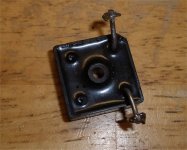 nukedbridge.jpg115.7 KB · Views: 161
nukedbridge.jpg115.7 KB · Views: 161 -
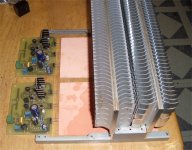 amplayout.jpg264 KB · Views: 240
amplayout.jpg264 KB · Views: 240 -
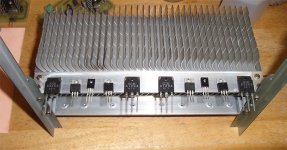 devicelayout.jpg336.5 KB · Views: 245
devicelayout.jpg336.5 KB · Views: 245
Elegant , huh ? More like "well researched". I studied the original Nikko amp to see how they implemented the dual supply. NO cap multiplier .. just a bridge and 2 caps. I was surprised to see no .1uF decoupling caps in either the low or high power supplies. (Below 1 ) I will have separate cap multipliers per channel fed by a single 65-0-65Vdc supply (1kuf - same as the nikko).
These designs are "right on" with the Nikko as far as grounding/layout , in fact .. the AX is even a little more refined. I also saw the Nikko feeds the drivers from the "high" (65v) supply , this would cause a bit more ripple to the rest of the voltage stage. I decided to compromise , run the drivers from the unregulated 65v and feed the individual voltage stages from the cap multipliers. In the end ..my voltage stages will be at +/-63.5v , drivers at +/-65 , and the OP devices (on their separate unregulated supply) running at +/-58V.
TOO MANY Choices ... I would ask for comments on whether I should run the drivers unregulated or filtered by the cap multiplier ????
... I would ask for comments on whether I should run the drivers unregulated or filtered by the cap multiplier ????
Here we are running "power hungry" BJT's. The drivers for both channels will draw up to a 1/3 amp with a 4R load at 120W+ !!
With this choice , I would need MJE15032/33 multipliers or at least MJE340/350's (a full .5A SOA with the 2V drop in the multiplier).
Retrofitting into a existing design (below 2) is a precision endeavor. Ventilation , space (spacing) Dang ! , designing the kit will be easy.
The final amp will be a healthy 120W/240W (8/4R) , have a 10-20 year MTBF , and will be easily capable of 3-400 watt peaks (4R). About $40USD in parts , and you will have a BETTER amp than the NIKKO or most other projects on the forums.
OS
These designs are "right on" with the Nikko as far as grounding/layout , in fact .. the AX is even a little more refined. I also saw the Nikko feeds the drivers from the "high" (65v) supply , this would cause a bit more ripple to the rest of the voltage stage. I decided to compromise , run the drivers from the unregulated 65v and feed the individual voltage stages from the cap multipliers. In the end ..my voltage stages will be at +/-63.5v , drivers at +/-65 , and the OP devices (on their separate unregulated supply) running at +/-58V.
TOO MANY Choices
Here we are running "power hungry" BJT's. The drivers for both channels will draw up to a 1/3 amp with a 4R load at 120W+ !!
With this choice , I would need MJE15032/33 multipliers or at least MJE340/350's (a full .5A SOA with the 2V drop in the multiplier).
Retrofitting into a existing design (below 2) is a precision endeavor. Ventilation , space (spacing) Dang ! , designing the kit will be easy.
The final amp will be a healthy 120W/240W (8/4R) , have a 10-20 year MTBF , and will be easily capable of 3-400 watt peaks (4R). About $40USD in parts , and you will have a BETTER amp than the NIKKO or most other projects on the forums.
OS
Attachments
The final amp will be a healthy 120W/240W (8/4R) , have a 10-20 year MTBF , and will be easily capable of 3-400 watt peaks (4R). About $40USD in parts , and you will have a BETTER amp than the NIKKO or most other projects on the forums.
OS
I think I speak for many when I say we are salivating for the final release of this "Pure Breed" ('Mongrel' seems so inappropriate after all your effort in refining the design...)
- Status
- This old topic is closed. If you want to reopen this topic, contact a moderator using the "Report Post" button.
- Home
- Amplifiers
- Solid State
- The MONGREL (supersym II)
